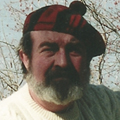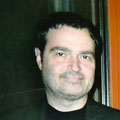North East River
The Social Experiment of North East, Maryland, Green Bank, Turkey Point, Red Point Beach, and Tilghman Island, Maryland
By Lon D. Campbell
March 5, 2008
The original line drawing or schematic of a pound net setup designed exclusively for the Northeast River was done in pencil by Jeff Purner on lined paper such as this and was meticulously drawn in two versions, both with boats and without. His given name was Jeff, but he went by Jethro and, as we used to say, he was quite a piece of work.
I called him a true friend, and he could always be counted on to have something on the hip. He was a waterman by trade and all that went with it, and as a young man he plied the waterways of the Northeast River, catching literally thousands of pounds of fish for commercial trade to the market. He could be found sitting on a fish box mending net or pondering the complexities of life as a waterman. He might even be known to share the pull on a half pint or drink a beer or two. The last time I saw him his first words were, “What have you got on the hip?” A true Jethro question. He was mending net at the time, although the art of mending net had long gone the way of the scuttle, cotton net, net rings, and corks.
As Jethro’s life progressed into midlife, he began to get more involved in horseback riding at Hilltop Ranch, and I began to drift away. I would occasionally see him out and about, and we remained fast friends throughout our lives. He was a good man to have in your corner, and I liked him very much. He could always be found at the Hilltop Inn, when it really was the Hilltop Inn, and he always seemed to drive a red Ford pickup truck. I remember once he picked me up in one of his red trucks and for reasons yet unexplained we made a trip bar hoppin’, which entailed cutting across the median without benefit of the crossover, which seemed like a good thing to do at the time. He suggested that we go drink a few beers, which also seemed like a good thing to do at the time. He was just that kind of friend and I miss him very much, as we always do close friends. As I have gotten older, my good and real friends cause a deeper loss as they pass away.
There are so many things that make up the business of running a fishery of that magnitude. There was location. Harvey’s Fish House where the North East museum is now and Boyd’s Wharf, which no longer exists and where the boys from North East still ply their trade. Men such as “Pip” Pratt and his brother Frank. The location is a “flat ground” operation with no existing buildings. All of the equipment is located in stockpiles around the property, and the land is rented from St. Mary Anne’s Parish, owners of the property whom Pip and others pay rent to.
The setup is somewhat like it was in the old days, and I would for one like to see it stay that way for a long time to keep the old way alive, although I doubt that it will make much of a difference. Some of the old boats and scows are beached and breached on the far shore and have been as such for years. The tar pot rigs are still in evidence, and the net poles still get a fresh coat every spring, as do the “nets,” “gismos,” and “gear.” (This is to show how little if any knowledge the average person has of the operation of fishing.)
The workboat itself must be mentioned. The so-called Bay Boat, which has been around forever with its scalloped bow and its beautiful lines. One must always mourn the loss or death of the “bushwhack boat,” which died in the ‘60s, although “Duck” Foreaker and others kept it alive for years afterward, if not more in memory than in fact, and Jack Manning kept it alive in actuality in the annual decoy shows and display shows that they have struggled to keep alive. I wish them all well in their efforts, but I fear that, like so many things that die on the proverbial vine, it may be that it too will die a sad mournful death.
Oars and oar locks. I still buy them up, when I find a good pair. Especially loom oars with the beautiful turned out diagonal oars and the old brass or galvanized oar locks, although if anyone has seen a set of brass oar locks recently, please give me a call.
Bay dogs and water dogs and labs of all kinds and any kind of dog that works the water. Praise be to them all, for they too were part of the fishery and amounted to a fair part of what fishing meant to the people who worked the water. For you see, it wasn’t just fishing that went into the Upper Bay, but hunting as well. In the fall the hunting season began in full bloom and the hunting dog came forth, blacks, and browns, reds, and tans, etc. Big and little, but not too little. Dogs to brag about and not to say too much about and dogs that were a pleasure to own. Dogs that had a long line and ones that were of questionable ownership. All of this made for a “trick bag of creatures great and small.”
Fishing shanties and shoreline shacks. All of the locations needed places to operate out of, the least of all the shorelines of all the locations aforementioned. Red Point Beach was probably the most, if not one of the most, populated of all locations for both fishing as well as hunting. Many stories persist of drunken parties where countless decoys were burned in “chunk stoves” in the fall and winter. Decoys that then weren’t worth anything, but now are worth hundreds of dollars apiece. The fishing and hunting from those shanties were amazing. The methods were to use layout rigs, sinkboxes, decoy spreads, shore line rigs, etc.
To conclude this story, I have indeed come full circle. The pound net has been described in full detail and design, both in drawn form and in descriptive narrative in this missive, so that is it. Another story draws to a close.






